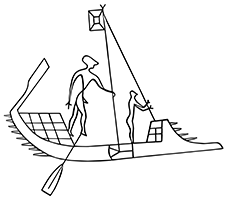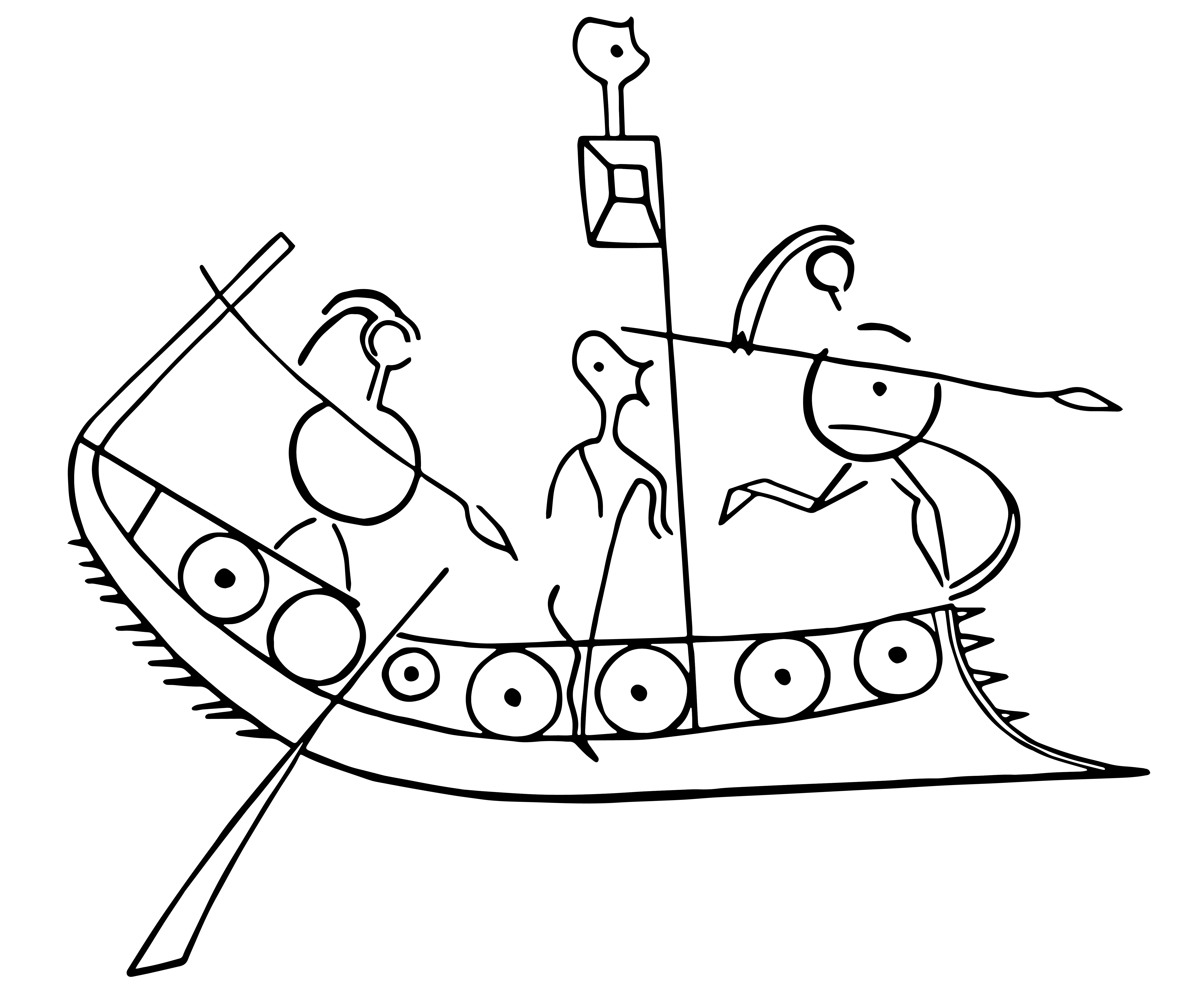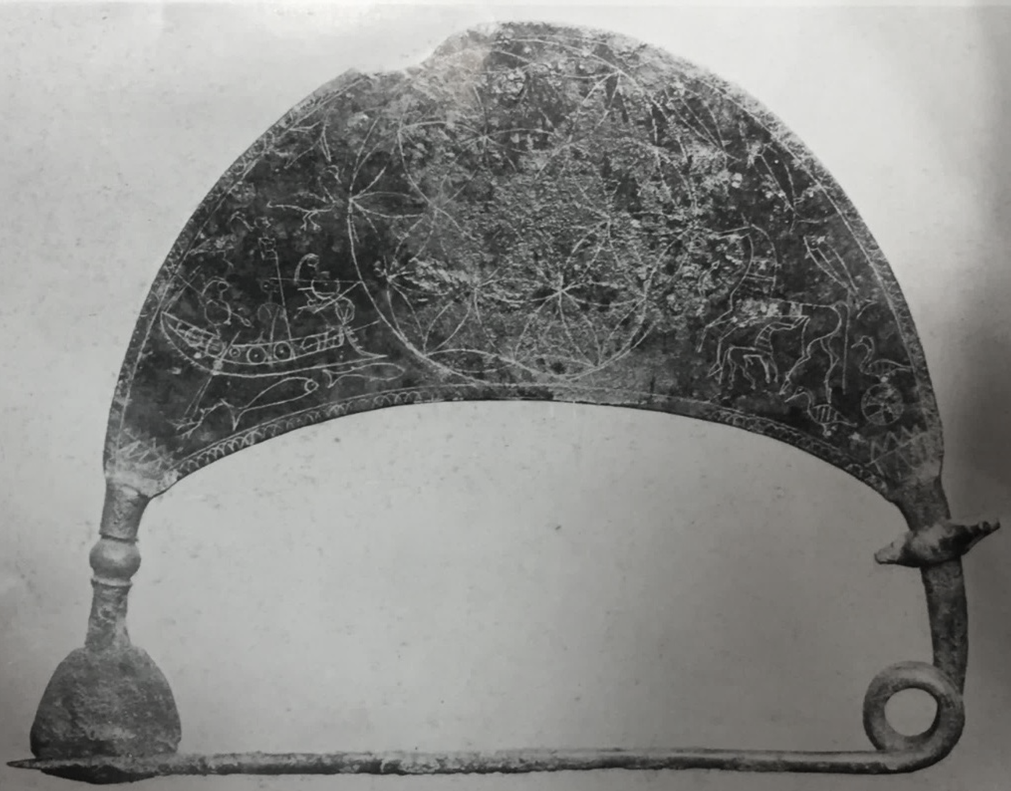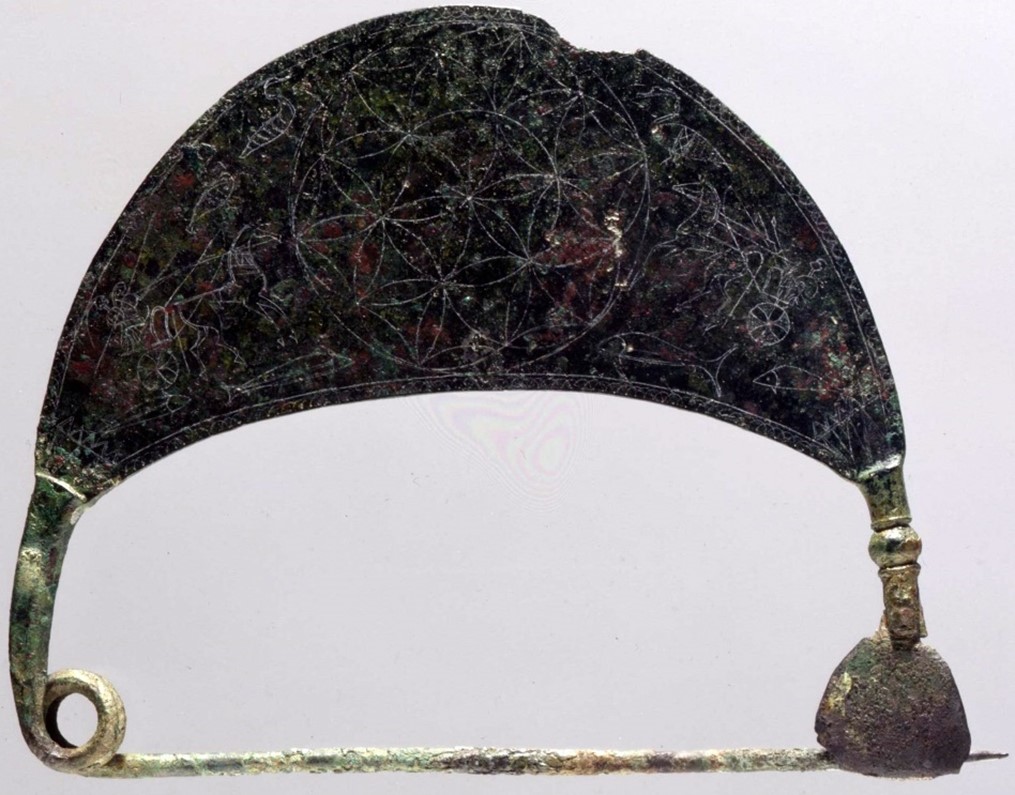Single-levelled ship to the right with a low flat hull. Triangular bow with a concave stempost integrating a ram that tapers into a pointed tip. The stempost ends in an incurving horn device that curves inward parallel to the hull. There are four short horizontal timbers tapering to a pointed tip projecting from the stermpost. The sternpost is high and incurving, bending sharply inward at the level of the upper edge of the aftercastle into a straight device with a rectangular tip. The aftercastle consists of a rectangular railing. The quarter rudder is set just forward of the aftercastle and widens towards the oar blade into a roughly triangular shape. Above the gunwale is a bulwark lined with round shields. These continue along the railing of the aftercastle. The mast is slightly forward of amidships with a single forestay and a crow's nest that hangs on the afterside of the masthead, rendered as a rectangle with a smaller square inside, their corners joined by oblique lines. Protruding from the crow's nest is the head of a figure, which unlike the warriors wears no helmet. Two of the warriors appear to stand at the level of the bulwark above the gunwale, which suggests a partial longitudinal deck if their positioning is considered not merely incidental.
Single-levelled galley
A70
c. 680 B.C.
Thisbe, Boeotia
L: 21 cm
Bronze fibula with the bow formed from a thin, vertical, crescent-shaped plate with incised decoration. The foot is a moulded knob terminating in a flat piece bent up to hold the pin. Above the spiral at the head are six spikes with rosettes on their tips. Considered by the same hand as Berlin 31013b
Basch 1987: 192, no. 404; Brouwers 2010: 121,462, pl. 34.1; Cherici 2006: 358, fig. 16; Coldstream 2003: 187, fig. 66c; Hampe 1936: no. 62a, pl. 4; Morrison and Williams 1968: 75, Arch. 8, pl. 8c
The shape of the fibula is identical to that of BM 1898.0226.1 and Berlin 31013a.
Side A: A large circular emblem occupies the center, with the figured scenes on either side as customary for this type. The left and right corners show the same composition arranged in an antithetical manner, consisting of a chariot with two warriors equipped with spears and round shields. These are framed by two fish swimming below and 1-2 birds hovering above. At either end of the bow are chevron patterns
Side B: A large circular emblem occupies the center as on side A. In the left corner is a ship facing to the right with three warriors on board equipped with spears and rounded shields. The warrior at the bow is captured in a moment when he is about to throw his spear, while the warrior at the stern stands on the aftercastle, spear at the ready. Both of them stand at the level of the upper horizontal representing the railing of the bulwark. The figure amidships on the other hand does not have military equipment and stands at a lower point, his legs overlapping with the bulwark. A group of seven round shields are shown suspended on a bulwark above the gunwale. Two fishes swim below while two birds hover above. In the right corner is another chariot composition. Two fishes swim below and a bird hovers above. At either end of the bow are chevron patterns.
Basch, L. 1987. Le musée imaginaire de la marine antique. Athens: Institut Hellénique pour la preservation de la tradition nautique.
Brouwers, J. J. 2010. “Warfare and Society in Early Greece: From the fall of the Mykenaian Palaces to the end of the Persian Wars.” PhD Thesis, Vrije Universiteit, Amsterdam, Netherlands.
Cherici, A. 2006. “Talassocrazia: aspetti tecnici, economici, politici con un brevissimo cenno a Novilara, Nesazio e ai Feaci,” Annali della Fondazione per il Museo “Claudio Faina” 13: 439-482.
Coldstream, J.N. 2003. Geometric Greece: 900-700 B.C. 2nd ed. London: Routledge.
Hampe, R. 1936. Frühe griechische Sagenbilder in Böotien, Ate¬ne : Deutsches archäologisches institute.
Morrison, J.S. and R.T. Williams. 1968. Greek Oared Ships: 900-322 B.C. Cambridge: Cambridge University Press.







